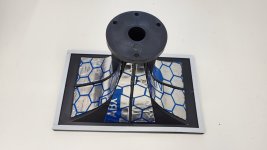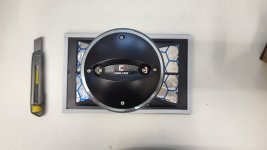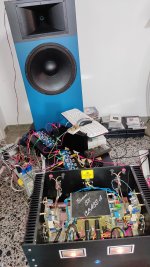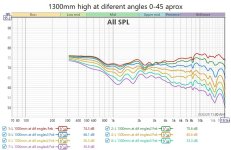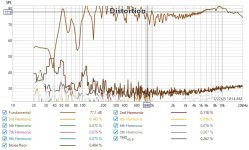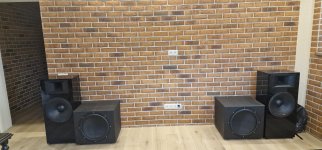One thing that should not be underestimated, at least in houses with stone walls, is the room gain.
Under the lowest resonance of the room, you get up to +12dB in bass.
For example, I have two resonances at 36 and 27 Hz. Below that, it goes down to about 18 Hz in the room with the same level as at 100 Hz.
Subwoofers are often set much louder in this range, but there is definitely no lack of bass in my room.
Under the lowest resonance of the room, you get up to +12dB in bass.
For example, I have two resonances at 36 and 27 Hz. Below that, it goes down to about 18 Hz in the room with the same level as at 100 Hz.
Subwoofers are often set much louder in this range, but there is definitely no lack of bass in my room.
There is not much to report from up north, except that Asathor performs better and better each day.
Earlier I detected some fuzziness in the upper mid-tones with complex music. Now they sing much cleaner.
The best «hack» was replacing my trusty Class A Luxman with Burmester 101. The Harbeths perform best with the former. Asathor preferred the latter, no doubt.
My next plan is to dampen the horns. Has anyone done it and experienced a noticeable positive result?
Earlier I detected some fuzziness in the upper mid-tones with complex music. Now they sing much cleaner.
The best «hack» was replacing my trusty Class A Luxman with Burmester 101. The Harbeths perform best with the former. Asathor preferred the latter, no doubt.
My next plan is to dampen the horns. Has anyone done it and experienced a noticeable positive result?
Agree- for another datapoint, my bass bins roll off below 50 as aligned. In my basement space, they're pretty darn smooth and flat to 20. There's 4x12" per side so modal behavior is pretty distributed.One thing that should not be underestimated, at least in houses with stone walls, is the room gain.
Under the lowest resonance of the room, you get up to +12dB in bass.
For example, I have two resonances at 36 and 27 Hz. Below that, it goes down to about 18 Hz in the room with the same level as at 100 Hz.
Subwoofers are often set much louder in this range, but there is definitely no lack of bass in my room.
I have. It is worth the little bit of money and effort involved. I did nothing extreme, just some damping materials on most surfaces.There is not much to report from up north, except that Asathor performs better and better each day.
Earlier I detected some fuzziness in the upper mid-tones with complex music. Now they sing much cleaner.
The best «hack» was replacing my trusty Class A Luxman with Burmester 101. The Harbeths perform best with the former. Asathor preferred the latter, no doubt.
My next plan is to dampen the horns. Has anyone done it and experienced a noticeable positive result?
Attachments
It's a pdf where you can read this.
"The amplifi er operates Class A to 25 watts (50 peak), and the distortion is 2nd
and 3rd harmonic in character, rising or declining in linear proportion to the output
power. The amplifi er has a direct coupled input and output, with a -0.5 dB rolloff
around .1 Hz and 200 KHz. It does a clean square wave at 100 KHz."
"The amplifi er operates Class A to 25 watts (50 peak), and the distortion is 2nd
and 3rd harmonic in character, rising or declining in linear proportion to the output
power. The amplifi er has a direct coupled input and output, with a -0.5 dB rolloff
around .1 Hz and 200 KHz. It does a clean square wave at 100 KHz."
Attachments
The report on Asathor can be found here:
https://www.der-akustische-untergrund.de/speakers/power-hifi-projects/asathor-preiswerte-männerbox/
However, it is in German, but DeepL can translate it very well.
Here are the measurements from 0-45°. Please note that the bass was not measured, so there is no weakness below 200Hz.

https://www.der-akustische-untergrund.de/speakers/power-hifi-projects/asathor-preiswerte-männerbox/
However, it is in German, but DeepL can translate it very well.
Here are the measurements from 0-45°. Please note that the bass was not measured, so there is no weakness below 200Hz.
I have a mono record using UMIK 1.
Player via YouTube,terible room acoustic..
I don't know if it's usefull but i post here.
Player via YouTube,terible room acoustic..
I don't know if it's usefull but i post here.
Attachments
Last edited:
Complete Sp[eaker in the midle of the room.
Tweeter high=1300mm.
Umic high=1300mm.
At different angles 0-45 dereace aprox.
Comments please.
Tweeter high=1300mm.
Umic high=1300mm.
At different angles 0-45 dereace aprox.
Comments please.

Attachments
Post 843 the chart labels do not show different angles. They show different" Fet".
Last chart on axis HD, looks pretty good. You are showing 2nd harmonic 30-40 db down. My only reference, Peavey SP2 (2004) 2nd harmonic 25 db down @ 5 W. Your wattage at the HD measurement would be useful information.
Last chart on axis HD, looks pretty good. You are showing 2nd harmonic 30-40 db down. My only reference, Peavey SP2 (2004) 2nd harmonic 25 db down @ 5 W. Your wattage at the HD measurement would be useful information.
Thanks for your reply indianajo.
My first question,not the labels🙂
Do i have to readjust the volume every time i change angles?
If I well understood , you wish a measurement at 5w to compare?
I wish to know how Rese66 have done the test at post#849.
I mean what software he had used,and some assistance how to reproduce this measurement.🙏
My first question,not the labels🙂
Do i have to readjust the volume every time i change angles?
If I well understood , you wish a measurement at 5w to compare?
I wish to know how Rese66 have done the test at post#849.
I mean what software he had used,and some assistance how to reproduce this measurement.🙏
No, you don't need to adjust for every angle, that would be very wrong.
The dispersion of the horn is not really interesting, its directivity is known. Only region of interest is where woofer and horn overlap. You could improve things in that region if you would drive them active and had a DSP to delay the woofer for example.
You can play with the passive parts as well, but not anything you can measure will be audible or an improvement.
The dispersion of the horn is not really interesting, its directivity is known. Only region of interest is where woofer and horn overlap. You could improve things in that region if you would drive them active and had a DSP to delay the woofer for example.
You can play with the passive parts as well, but not anything you can measure will be audible or an improvement.
Thank you Turbowatch2!
Active drive isn't an option for me ,at least now.
If playing with passive parts isn't audible,I prefer to leave as it.
Is the boom at 300hz-800hz that make me 🤔
Active drive isn't an option for me ,at least now.
If playing with passive parts isn't audible,I prefer to leave as it.
Is the boom at 300hz-800hz that make me 🤔
I am very happy with the sound of the Asathor. For this reason I want to make a center speaker with the speakers used in the Asathor.
Please help me with an advice, is it possible to use this configuration as in the picture with two bass speakers on the sides and the horn in the middle. If so, what changes should I make in the crossover?
Thank you very much for your help!
Please help me with an advice, is it possible to use this configuration as in the picture with two bass speakers on the sides and the horn in the middle. If so, what changes should I make in the crossover?
Thank you very much for your help!
Attachments
that is the MTM configuration, normally people place the speakers in vertical position instead of horizontal
It's certainly possible, but that WTW (Woofer/Tweeter/Woofer) arrangement will cause deep off axis cancellation nulls in the crossover region due to the unequal path lengths to the listener's ears (or a measurement mic) similar to what can be seen in Erin's vertical off-axis measurements of a JBL M2:Please help me with an advice, is it possible to use this configuration as in the picture with two bass speakers on the sides and the horn in the middle. If so, what changes should I make in the crossover?
The "suck out" (as much as -25dB) would occur either side of the center axis in an WTW.
A steeper crossover slope would reduce the bandwidth of the affected region, but the depth of the higher "Q" nulls will remain the same.
Off-axis response is even worse in a WTW than a WT, a cabinet tipped on it's side.
Tip one of your cabinets on it's side, and listen to vocals as you move side to side- easy to hear the change.
The center speaker should use the same configuration as the L/R to avoid ruining the horizontal pattern.
The center cabinet could be made wider and shorter to still contain the same internal volume as the Asathor, requiring no crossover change.
Art
- Home
- Loudspeakers
- Multi-Way
- Asathor - a JBL 4367 Clone
